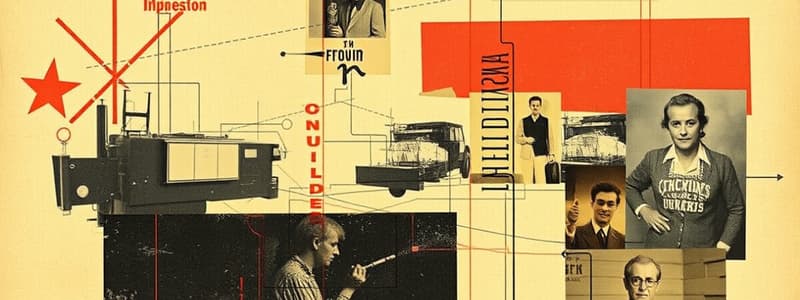Podcast
Questions and Answers
Which term refers to the use of touch in communication?
Which term refers to the use of touch in communication?
- Kinesics
- Vocalics
- Proxemics
- Haptics (correct)
What does chronemics refer to in communication?
What does chronemics refer to in communication?
- The study of body language
- The use of time as a factor (correct)
- The appearance of a person
- The distance maintained between individuals
Which aspect of communication primarily focuses on the voice, including volume and pitch?
Which aspect of communication primarily focuses on the voice, including volume and pitch?
- Artifacts
- Vocalics (correct)
- Proxemics
- Kinesics
What is the purpose of clarity in communication?
What is the purpose of clarity in communication?
Which communication type occurs between two individuals?
Which communication type occurs between two individuals?
What does the term 'jargon' refer to in communication?
What does the term 'jargon' refer to in communication?
Which barrier to communication is associated with cultural norms?
Which barrier to communication is associated with cultural norms?
What defines proxemics in the context of communication?
What defines proxemics in the context of communication?
What is the role of the sender in communication?
What is the role of the sender in communication?
Which communication model focuses primarily on the dynamics of public speaking?
Which communication model focuses primarily on the dynamics of public speaking?
What is the function of feedback in the communication process?
What is the function of feedback in the communication process?
In the context of communication, what does noise refer to?
In the context of communication, what does noise refer to?
How does the Shannon Weaver model illustrate communication?
How does the Shannon Weaver model illustrate communication?
Which model of communication emphasizes a continuous and circular process?
Which model of communication emphasizes a continuous and circular process?
What does encoding refer to in the communication process?
What does encoding refer to in the communication process?
What type of noise involves distractions caused by physical elements?
What type of noise involves distractions caused by physical elements?
Flashcards are hidden until you start studying
Study Notes
Communication Process
- Communication involves transferring information between individuals or groups.
- The sender initiates the message for transmission.
- A message can be conveyed through words, speech, letters, pictures, or symbols.
- Encoding refers to expressing the message in an appropriate medium, which can be verbal or non-verbal.
- A channel is the medium through which the encoded message travels.
- A receiver is the intended recipient of the message.
- Decoding translates the encoded message into understandable language for the receiver.
- Feedback is the response from the receiver regarding the message.
Communication Barriers
- Noise refers to any interference that affects communication clarity.
- Physical noise includes loud sounds or distractions that hinder communication, like music or conversation.
- Physiological noise arises when the body interferes with communication.
- Psychological noise involves personal qualities that affect communication.
Communication Models
- Aristotle Model focuses on public speaking versus interpersonal communication.
- Transactional Model describes two-way communication, also known as the circular model.
- Shannon-Weaver Model illustrates how noise can hinder message delivery.
- Schramm Model emphasizes shared experiences between sender and receiver.
- Eugene White Model views communication as circular and continuous with no clear start or end.
- Berlo's Model consists of four components: Source, Message, Channel, Receiver.
- Helical Model proposed by Frank Dance compares communication to a helix that progresses over time.
Communication Types
- Verbal Communication uses words to convey information.
- Non-verbal Communication relies on body language, facial expressions, and other cues.
- Chronemics studies the role of time in communication.
- Vocalics examines voice aspects like volume, tone, and pitch.
- Haptics involves touch as a communication form.
- Kinesics analyzes body language.
- Proxemics studies the physical distance maintained during communication.
- Artifacts refer to appearance conveying information about personality.
Key Communication Principles
- Completeness ensures all necessary information is included in communication.
- Conciseness emphasizes using the least number of words necessary.
- Consideration involves understanding the audience when communicating.
- Clarity focuses on delivering a specific message clearly.
- Concreteness encourages particularity instead of generality in messages.
- Courtesy reflects the sender's respect towards the receiver through demeanor.
- Correctness ensures grammatical accuracy in communication.
Barriers to Communication
- Jargon can complicate messages with technical terms.
- Emotional Barriers may hinder the expression of feelings.
- Poor Retention results in difficulty remembering the message.
- Physical Difficulty can arise from barriers in the environment affecting communication.
- Non-verbal Barriers result from an inability to recognize non-verbal cues.
- Cultural Differences influence communication norms and styles.
Types of Communication Interactions
- Interpersonal Communication occurs between individuals.
- Dyad Communication specifically refers to interactions between two people.
- Small Group Communication involves three to twelve participants.
- Public Communication requires delivering messages to large groups.
- Mass Communication is disseminated through media like television, radio, newspapers, and books.
Studying That Suits You
Use AI to generate personalized quizzes and flashcards to suit your learning preferences.




